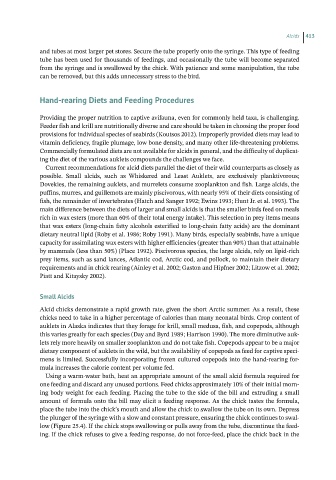Page 420 - Hand rearing birds second
P. 420
Alcids 413
and tubes at most larger pet stores. Secure the tube properly onto the syringe. This type of feeding
tube has been used for thousands of feedings, and occasionally the tube will become separated
from the syringe and is swallowed by the chick. With patience and some manipulation, the tube
can be removed, but this adds unnecessary stress to the bird.
Hand-rearingDietsand FeedingProcedures
Providing the proper nutrition to captive avifauna, even for commonly held taxa, is challenging.
Feeder fish and krill are nutritionally diverse and care should be taken in choosing the proper food
provisions for individual species of seabirds (Koutsos 2012). Improperly provided diets may lead to
vitamin deficiency, fragile plumage, low bone density, and many other life-threatening problems.
Commercially formulated diets are not available for alcids in general, and the difficulty of duplicat-
ing the diet of the various auklets compounds the challenges we face.
Current recommendations for alcid diets parallel the diet of their wild counterparts as closely as
possible. Small alcids, such as Whiskered and Least Auklets, are exclusively planktivorous;
Dovekies, the remaining auklets, and murrelets consume zooplankton and fish. Large alcids, the
puffins, murres, and guillemots are mainly piscivorous, with nearly 95% of their diets consisting of
fish, the remainder of invertebrates (Hatch and Sanger 1992; Ewins 1993; Hunt Jr. et al. 1993). The
main difference between the diets of larger and small alcids is that the smaller birds feed on meals
rich in wax esters (more than 60% of their total energy intake). This selection in prey items means
that wax esters (long-chain fatty alcohols esterified to long-chain fatty acids) are the dominant
dietary neutral lipid (Roby et al. 1986; Roby 1991). Many birds, especially seabirds, have a unique
capacity for assimilating wax esters with higher efficiencies (greater than 90%) than that attainable
by mammals (less than 50%) (Place 1992). Piscivorous species, the large alcids, rely on lipid-rich
prey items, such as sand lances, Atlantic cod, Arctic cod, and pollock, to maintain their dietary
requirements and in chick rearing (Ainley et al. 2002; Gaston and Hipfner 2002; Litzow et al. 2002;
Piatt and Kitaysky 2002).
SmallAlcids
Alcid chicks demonstrate a rapid growth rate, given the short Arctic summer. As a result, these
chicks need to take in a higher percentage of calories than many neonatal birds. Crop content of
auklets in Alaska indicates that they forage for krill, small medusa, fish, and copepods, although
this varies greatly for each species (Day and Byrd 1989; Harrison 1990). The more diminutive auk-
lets rely more heavily on smaller zooplankton and do not take fish. Copepods appear to be a major
dietary component of auklets in the wild, but the availability of copepods as feed for captive speci-
mens is limited. Successfully incorporating frozen cultured copepods into the hand-rearing for-
mula increases the calorie content per volume fed.
Using a warm-water bath, heat an appropriate amount of the small alcid formula required for
one feeding and discard any unused portions. Feed chicks approximately 10% of their initial morn-
ing body weight for each feeding. Placing the tube to the side of the bill and extruding a small
amount of formula onto the bill may elicit a feeding response. As the chick tastes the formula,
place the tube into the chick’s mouth and allow the chick to swallow the tube on its own. Depress
the plunger of the syringe with a slow and constant pressure, ensuring the chick continues to swal-
low (Figure 25.4). If the chick stops swallowing or pulls away from the tube, discontinue the feed-
ing. If the chick refuses to give a feeding response, do not force-feed, place the chick back in the

